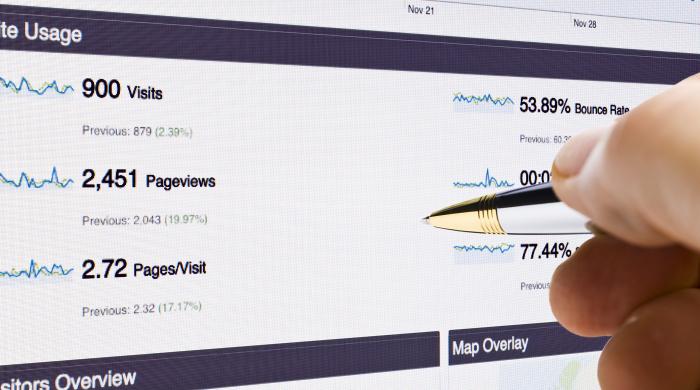A History of Google Panda

A few years ago, Google unleashed a marauding beast into the world of search engine optimisation. It’s been crashing through the online undergrowth ever since, passing over some sites, mauling others. The impact of the search ranking filter Google Panda has been felt in shockwaves across the entire web since it was first introduced in 2011.
No doubt you’ve been warned multiple times to beware of Google Panda, and it may not be entirely clear why. We’ve put together a history of Google Panda – including a whistle-stop tour of all the updates – so you can learn more about this notorious search engine algorithm. What prompted Google to develop it in the first place? How has it changed, and what have the consequences been?
Birth of a Beast
Panda exists to ensure that sites offering bad quality content achieve significantly lower search engine rankings than sites with good quality content. That was its original aim, and it has the same mission today.
The existing system used by Google was missing the mark, unable to filter quality sites effectively, albeit delivering all the other sophisticated nuances of search that users wanted. SEOs and webmasters had learned how to take advantage of the loopholes in the algorithm: many web pages became content farms, written purely to manipulate the search engine results and not for human use. They provided cruddy, dull content that was bloated with keywords, and completely lacking in value for users. Google needed a fix that didn’t rely on the main algorithm.
By April 2011, two months after Panda’s launch, CNET(1) was reporting that the filter had indeed wreaked havoc on some sites – notably content farms or sites crammed with ads. SearchEnglineLand.com News Editor Barry Schwartz put it like this: “People who got hit were trying everything to get their sites out of it. It was targeting low quality content sites.”
But that’s not all it hit. Many perfectly respectable and high-quality sites like the BMJ (British Medical Journal), PR Newswire and Cult of Mac (2) took a severe clobbering too – sinking from their formerly high rankings to languish on pages few were likely to see.
Google has since refined its filter with a series of updates. In May 2011 it published a 23-bullet point list for webmasters, explaining how Google determines good quality content, and (implicitly) how to avoid incurring the wrath of Panda. (3)
A Panda Timeline
A little confusingly, not all of the 27 updates so far amounted to a new version of Panda – so we’re not at Panda 27, but an updated Panda 4. Following SearchEngineLand.com, we’ll call it Panda 4.1. Here’s how the update timeline unfolded:
- February 24th 2011: Panda Update #1 (also known as Panda 1.0). This little beast was rolled out in the US only and filtered English language sites, shoving 11.8 per cent of them deep into the bowels of search pages. This was unprecedented – affecting far more sites than any of Google’s previous algorithm changes.
- April 11th 2011: Panda Update #2 (Panda 2.0). This version was rolled out internationally in English and zapped the traffic coming to 2 per cent of sites – including the New York Times’ About.com (4)).
- May 10th 2011: Panda Update #3. (Panda 2.1) Panda 2.1 was a relatively minor update and wasn’t announced by Google. However, it did confirm some of its ‘tweaks’ after some gimlet-eyed SEOs noticed changes to web traffic on certain sites. Google insisted that far fewer sites were affected by the change than by previous updates.
- June 16th 2011: Update #4 (Panda 2.2). Unannounced but subsequently confirmed, this update was designed to improve the algorithm’s detection of sites which ‘scrape’ content (often without permission) from other sites and have no original content of their own. At this point, Danny Sullivan (founding editor of SearchEnglineLand.com) was arguing that Panda was a ranking factor rather than an algorithm update – a value like Google’s ‘PageRank’ (which counts links as though they were votes) that feeds into the overarching Google algorithm system. As he put it: “If it helps consider it as if every site is given a PandaRank score – those low in Panda come through OK; those high get hammered by the beast.” (5)
- July 23rd 2011: Update #5 (Panda 2.3). Another unannounced update, this one was belatedly confirmed like those before it. Some SEOs suspected that Panda had become a rolling update, although when questioned by journalist Barry Schwartz, Google insisted that the updates were being pushed out manually.
- August 12th 2011: Panda Update #6 (Panda 2.4). Panda goes multilingual, launching internationally in virtually all languages (only Chinese, Japanese and Korean were excluded). Google announced that 6-9 per cent of queries in its non-English indexes were hit.
- September 28th 2011: Panda Update #7 (Panda 2.5). Not only did Google not announce the seventh tweak, it declined to give any details about it either. After traffic changes were noticed, it simply confirmed the revision.
- October 19th 2011: Panda Update #8 (Panda 3.0 arrives). This update was actually announced. With Google’s Matt Cutts tweeting a ‘weather report’ which warned of ‘Panda-related flux’ over the coming few weeks that would have less of an impact than previous updates (~2%). The ‘flux’ referred to an ongoing series of small updates involving algorithm and site recalculation over several weeks.
- November 18th 2011: Panda Update #9 (Panda 3.1) Again, this one was announced only after it was pushed out and was said to involve ‘minor’ changes (a little more flux perhaps) affecting less than one per cent of searches. Google agreed to deliver more frequent ‘weather reports.’
- January 18th 2012: Panda Update #10 (Panda 3.2). Well, so much for those weather reports. Panda 3.2 wasn’t announced, but was confirmed when Google was approached by Barry Schwartz. This one involved no additional algorithm changes or new signals – only a data refresh.
- February 27th 2012: Panda Update #11 (Panda 3.3). Another announced update, 3.3 was said to be a data refresh, but actually also included the switching off of a link evaluation signal that it had been using for years – plus the application of traditional algorithmic ranking factors to local search results.
- March 23rd 2012: Panda Update #12 (Panda 3.4) Announced by tweet and described as a Panda ‘refresh’, 3.4 affected only 1.6 per cent of queries.
- April 19th 2012: Panda Update #13 (Panda 3.5). Matt Cutts belatedly announced this update after SearchMetrics published a list of update winners and losers. The latter included press portals, aggregators and sites that were very template heavy.
- April 27th 2012: Panda Update #14 (Panda 3.6). The first time Google had issued an update within mere days of the previous one (updates typically occur within six weeks or so), 3.6 wasn’t announced – although it was subsequently confirmed. No details were divulged.
- June 9th 2012: Panda Update #15 (Panda 3.7). Another unannounced update, belatedly confirmed after rumours of a refresh began circulating on Webmaster forums, this one affected less than one per cent of US search queries (one per cent worldwide).
- June 25th 2012: Panda Update #16 (Panda 3.8). This one was announced and affected less that one per cent of worldwide queries.
- July 24th 2012; Panda Update #17 (Panda 3.9). Announced a few hours before being pushed out, 3.9 affected approximately one per cent of search results.
- August 20th 2012: Panda Update #18 (Panda 3.9.1). Confirmed a few days after being pushed out, but again unannounced, this one was billed as ‘minor’ – affecting just one per cent of queries. Future Panda updates, Google claimed, would be smoother and more consistent.
- September 18th 2012: Panda Update #19 (Panda 3.92). Announced as another bearer of Panda flux for a few days, this update affected 0.7 per cent of queries.
- September 27th 2012: Panda Update #20 (Panda 3.93, or ‘Panda 20’ as it was the 20th update). Even though it was a fairly major update that affected 2.4 per cent of English search queries (and involved an algorithm update, not just a data refresh), Google announced it belatedly after it had already done a fair bit of traffic mauling.
- November 5th 2012: Panda Update #21. Unannounced but confirmed in response to queries, this one affected 1.1 per cent of English US queries but just 0.4 per cent worldwide.
- November 21st 2012: Panda Update #22. Confirmed a day after the event but not announced, Panda 22 affected 0.8 per cent of English queries.
- December 21st 2012: Panda Update #23. Confirmed by tweet (as before, only in response to rumours of an update), Panda 23 noticeably affected more queries than its predecessor at 1.3 per cent.
- January 22nd 2013: Panda Update #24. Why Google chooses to announce some updates but not others remains shrouded in mystery. This one was announced, and affected 1.2 per cent of English queries.
- March 15th 2013: Panda Update #25. Google clarified that they were unlikely to confirm future Panda updates as it was about to be incorporated into the overall indexing processes (i.e., this would be the last manual push). They did confirm that this one was in the pipeline but said nothing when it kicked in.
- May 20th 2014: Panda Update #26 (Panda 4.0 is born). Despite the earlier warning that no further confirmations would occur, this one was announced – suggesting that it was a major change. It affected different languages in different ways, hitting approximately 7.5 per cent of English queries noticeably.
- September 25th 2014: Panda Update #27 (Panda 4.1). Another hefty update, this one was both announced and confirmed, and affected 3-5 per cent of queries.
Google says that it conducts around 500 updates every year to its algorithms. This, they say, would make announcements for all of them tedious and cumbersome.
The reality is some updates, and particularly the Panda updates, have caused many websites to vanish without trace. Those that have followed the Google guidelines have cleaned up their act and got their traffic back, but many small sites have struggled to survive after an update in the darkness of the search results wilderness.
References
- McCullagh, D. 2011 (April 18th) Testing Google's Panda algorithm: CNET analysis (http://www.cnet.com/news/testing-googles-panda-algorithm-cnet-analysis/)
- Leander Kahney, 2011 (February 18th) Cult of Mac Has Been Hit By Google’s War On Content Farms (http://www.cultofmac.com/84080/cult-of-mac-has-been-hit-by-googles-war-on-content-farms/84080/)
- Google, 2011 (May 6th) More guidance on building high-quality sites (http://googlewebmastercentral.blogspot.co.uk/2011/05/more-guidance-on-building-high-quality.html)
- Matt McGee, 2011 (April 29th) New York Times: Yes, Google’s Panda Update Hit NYT-Owned About.com (http://searchengineland.com/googles-panda-update-hit-about-com-75145)
- Danny Sullivan 2011 (June 21st) Why Google Panda Is More A Ranking Factor Than Algorithm Update http://searchengineland.com/why-google-panda-is-more-a-ranking-factor-than-algorithm-update-82564
- http://searchengineland.com/googles-panda-update-launches-internationally-in-most-languages-89214
Posted: 20/11/2014







